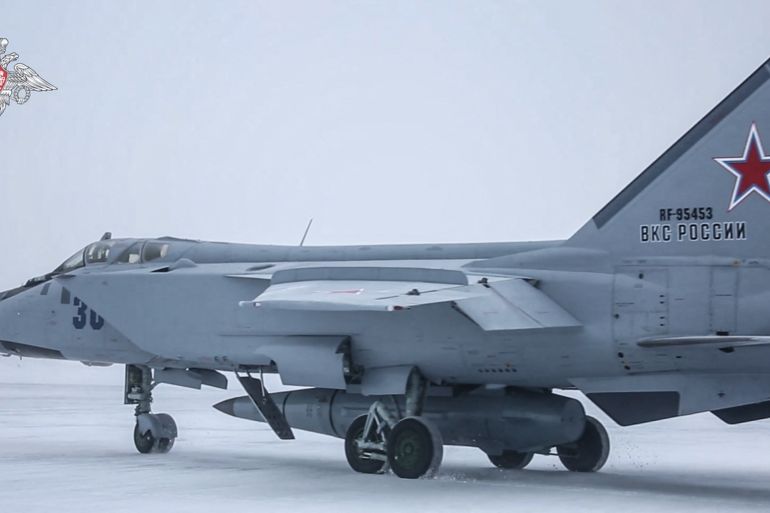What are the hypersonic missiles Russia is using in Ukraine?
Russia bombarded Ukraine with Kinzhal missiles, which fly many times faster than the speed of sound, and are impossible to shoot down with ground defences.

Published On 10 Mar 2023
Russia unleashed a barrage of high-precision missile attacks on Ukraine that triggered a wave of power cuts and temporarily caused Europe’s biggest nuclear power plant to lose power.
According to Ukraine’s military, Russia is believed to have used six Kinzhals – hypersonic missiles which fly many times faster than the speed of sound.
President Vladimir Putin regularly touts the Kinzhal, which means “dagger” in Russian, as a weapon for which the NATO alliance backing Kyiv has no answer.
Here is what you need to know about the weapon:
What are hypersonic missiles?
- Hypersonic weapons travel in the upper atmosphere at more than five times the speed of sound – or about 6,200kmph (3,852mph) – and they can evade advanced radar systems.
- There are two major types of hypersonic missiles. One is the hypersonic glide vehicle (HGV), which leaves the Earth’s atmosphere and then plunges back into it.
- The second is the hypersonic cruise missile (HCM) which, while not as fast, flies low and at extremely high speeds, giving opponents little time to react. They can also carry a nuclear warhead.
![The Kinzhal is capable of striking targets 2,000 kilometers (1,250 miles) away at a speed 10 times the speed of sound [File: Sergey Pivovarov/Reuters]](/wp-content/uploads/2022/03/2019-06-19T113747Z_992183847_RC1861594010_RTRMADP_3_RUSSIA-DEFENCE-MISSILE.jpg?w=770&resize=770%2C500)
What are the key features of Kinzhal missiles?
- Kinzhal is an air-launched ballistic missile that is capable of carrying nuclear or conventional warheads.
- It has a reported range of 1,500-2,000km (930-1,240 miles) with a payload of 480kg. The missiles may reach speeds of up to Mach 10 (12,350kmph or 7,674mph).
- President Vladimir Putin says Russia is the global leader in hypersonic missiles whose speed, manoeuvrability, and altitude make them difficult to track and intercept.
- In Ukraine, the missiles were first used in March 2022 to destroy a fuel depot, according to Moscow.
- On Thursday, Yurii Ihnat, spokesman for Ukraine’s air force, said his country did not have the capability to “counter” the Kinzhals.
Who else is developing hypersonic missiles?
- The United States has actively pursued the development of hypersonic weapons – manoeuvring weapons that fly at speeds of at least Mach 5 – as a part of its Conventional Prompt Global Strike programme since the early 2000s, according to a congressional report.
- In April 2022, Australia, the United Kingdom and the US – a grouping known as AUKUS – agreed to cooperate on hypersonic weapons and electronic warfare capabilities.
- China is also aggressively developing the technology, according to the US Congressional Research Service (CRS).
- Iran, Israel and South Korea have conducted basic research on the technology, the CRS has said previously.
Source: Al Jazeera and news agencies